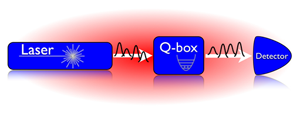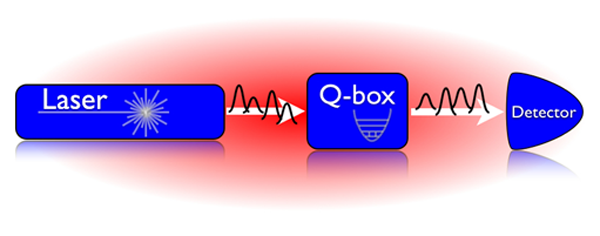Shedding Light on a Quantum Black Box
Quantum processors—devices designed to perform specific quantum transformations on a physical system—are at the core of novel protocols for quantum communication, measurement, and computing. Future quantum technologies will likely include different kinds of such devices, able to manipulate quantum states in accurately controlled ways. To guarantee the optimal overall performance of the system, the behavior of each quantum processor will have to be properly verified and completely characterized.
A quantum process is the operation performed by a quantum processor that transforms a quantum system’s state into a different one. For example, the well-known unitary operations correspond to reversible, deterministic transformations such as rotation of a photon’s polarization. But quantum processes also encompass more general transformations and can therefore also describe the coupling of the system with the environment and the action of quantum measurements [1,2].
Once researchers have built a quantum device, they can use a technique called quantum process tomography (QPT) to fully characterize the quantum process it implements. The most straightforward strategy consists of sending a large ensemble of known quantum states into the input of the device and measuring how the quantum process transforms them at the output. The method is so powerful that it even works in the case of a “quantum black box,” for which almost no preliminary information about the inner working mechanism is available (Fig. 1). In Physical Review Letters [3], Ranjeet Kumar and colleagues at the University of Calgary, Canada, present the experimental characterization of optical quantum processes using a fast and reliable new scheme for QPT. They use this procedure to fully characterize the fundamental quantum operations of photon creation and annihilation for the first time.
The QPT protocol used by Kumar and colleagues has the big advantage of requiring only a particularly simple class of states as the input probes. These probes are the well-known coherent states, which are easily obtained as the ordinary output of a laser source. All one has to do is to feed the optical quantum process with coherent light pulses of different amplitudes and phases while measuring the states of light appearing at the output. If sufficiently many probe states are used, the action of the quantum process under investigation—embodied mathematically in the so-called process tensor—can be fully reconstructed by tomography. From the knowledge of the process tensor, it is possible to predict the output state of the device, for example, the number of photons in a pulse, for any arbitrary quantum state at its input.
QPT with coherent states was first demonstrated in 2008, on simple optical elements [4]. Here the technique is extended to the experimental analysis of nondeterministic (nonunitary) quantum processes. In these cases the quantum device is not guaranteed to perform the desired state transformation all the time, but rather only occurs randomly. However, the events where the transformation happens are accompanied (“heralded”) by an ancillary signal.
Kumar and colleagues consider the elementary quantum processes of photon creation and annihilation. These operators were introduced in 1927 by Dirac, one of the fathers of quantum mechanics, to describe the behavior of the quantum harmonic oscillator. The creation (annihilation) operator has the effect of raising (lowering) the number of excitations, or energy quanta, of the system. In optics, the creation and annihilation operators act on a single mode of the electromagnetic field by creating or destroying one photon in the mode.
In 2004, Wenger et al. of the Laboratoire Charles Fabry de l’Institut d’Optique in Orsay, France, reported the first realization of the annihilation operator (or photon subtraction) in a quantum optics experiment [5]. The scheme consists of a beam splitter reflecting a small portion of the incoming beam toward a single-photon detector, which heralds the annihilation. When the detector clicks, the beam splitter removes a single photon from the beam. The transmitted state can be shown to be the result of the application of the annihilation operator to the input state. Photon subtraction was then used by Ourjoumtsev et al. to generate highly nonclassical states of light such as superpositions of small-amplitude coherent states called “Schrödinger’s kittens” [6], and to “distill” or concentrate noisy quantum-mechanical entanglement information shared by two parties [7].
In the same year, the Quantum Optics Group of the Istituto Nazionale di Ottica in Florence, Italy, first experimentally realized the photon creation operator by generating a new class of nonclassical states of light called photon-added coherent states [8], which had been theoretically analyzed in 1991 [9]. The experimental scheme relies on parametric down-conversion in a nonlinear crystal that is pumped by an intense laser beam. Photon pairs are spontaneously emitted in the process, and the detection of one photon of a pair can be used to herald the presence of the other. If a seed light field is used, stimulated emission kicks in, and the detection of the herald photon indicates the application of the creation operator to the injected seed field state. The experimental implementation of single-photon addition was then used to directly verify the commutation relations of a bosonic light field and the noiseless amplification of quantum states [10].
Although the experimental realization of the creation and annihilation operators is now well established, their full characterization was still missing. In their work, Kumar and colleagues demonstrate a previously proposed process tomography procedure to characterize these basic operators as simple quantum processes. A new reconstruction method, which is much more reliable and also able to deal with nondeterministic quantum processes, allows the authors to obtain a “map” (the process tensor) that connects the photon number probabilities of the incoming state to those of the output. For the annihilation (creation) operator one finds that the photon number is lowered (raised) with a probability connected to the incoming photon number, in accordance with the quantum-mechanical definition of these operators. The ability to tomographically characterize arbitrary quantum processes in a relatively simple way might make this technique a standard procedure for the development of new quantum optical devices. Furthermore, QPT with coherent states might become an essential tool to characterize complex quantum processor circuits, where several interconnected devices can be precisely analyzed, either separately or in their combined behavior. However, in such a case, using this characterization technique with processes acting on large Hilbert spaces or on multiple modes, might reveal limits related to the difficulty of reconstructing process tensors with a huge number of elements.
The possibility of extending the tomography of quantum processes to physical systems outside the realm of optics, such as to Bose-Einstein condensates, represents one of the next attractive challenges of this field of research.
References
- J. F. Poyatos, J. I. Cirac, and P. Zoller, “Complete Characterization of a Quantum Process: The Two-Bit Quantum Gate,” Phys. Rev. Lett. 78, 390 (1997)
- G. M. D’Ariano and P. Lo Presti, “Quantum Tomography for Measuring Experimentally the Matrix Elements of an Arbitrary Quantum Operation,” Phys. Rev. Lett. 86, 4195 (2001)
- R. Kumar, E. Barrios, C. Kupchak, and A. I. Lvovsky, “Experimental Characterization of Bosonic Creation and Annihilation Operators,” Phys. Rev. Lett. 110, 130403 (2013)
- M. Lobino, D. Korystov, C. Kupchak, E. Figueroa, B. C. Sanders, and A. I. Lvovsky, “Complete Characterization of Quantum-Optical Processes,” Science 322, 563(2008)
- J. Wenger, R. Tualle-Brouri, and P. Grangier, “Non-Gaussian Statistics from Individual Pulses of Squeezed Light,” Phys. Rev. Lett. 92, 153601 (2004)
- A. Ourjoumtsev, R. Tualle-Brouri, J. Laurat, and P. Grangier, “Generating Optical Schrödinger Kittens for Quantum Information Processing,” Science 312, 83 (2006)
- H. Takahashi, J. S. Neergaard-Nielsen, M. Takeuchi, M. Takeoka, K. Hayasaka, A. Furusawa, and M. Sasaki, “Entanglement Distillation from Gaussian Input States,” Nature Photon. 4, 178 (2010)
- A. Zavatta, S. Viciani, and M. Bellini, “Quantum-to-Classical Transition with Single-Photon-Added Coherent States of Light,” Science 306, 660 (2004)
- G. S. Agarwal and K. Tara, “Nonclassical Properties of States Generated by the Excitations on a Coherent State,” Phys. Rev. A 43, 492 (1991)
- A. Zavatta, J. Fiurasek, and M. Bellini, “A High-Fidelity Noiseless Amplifier for Quantum Light States,” Nature Photon. 5, 52 (2011)





